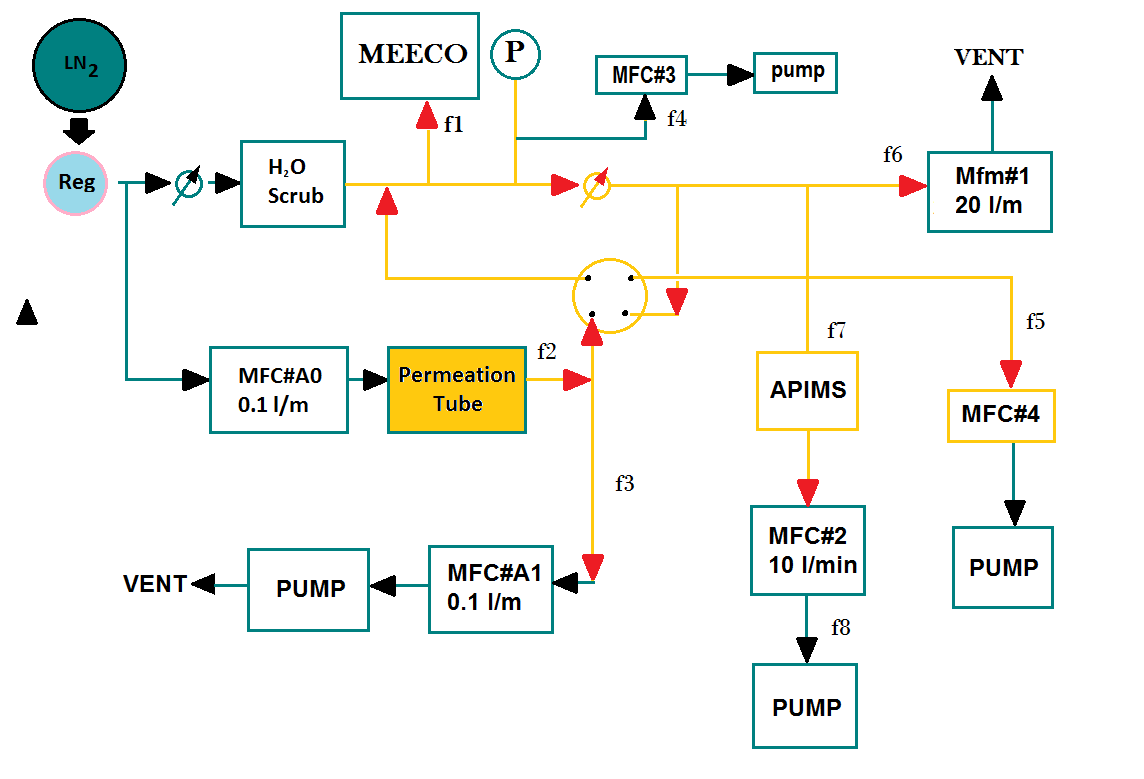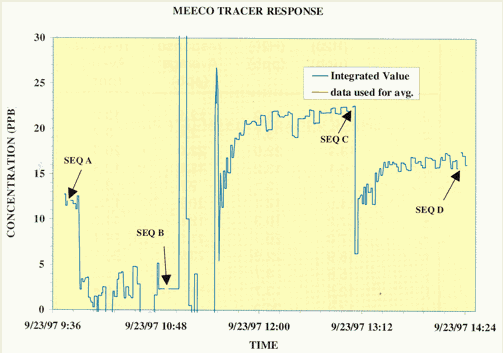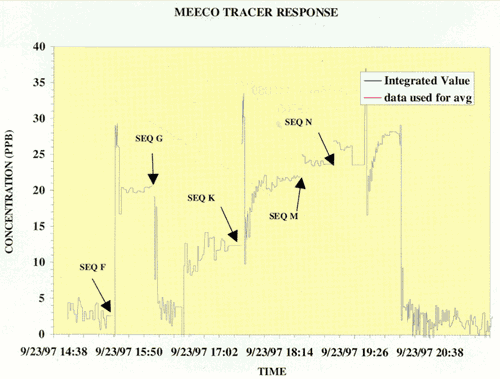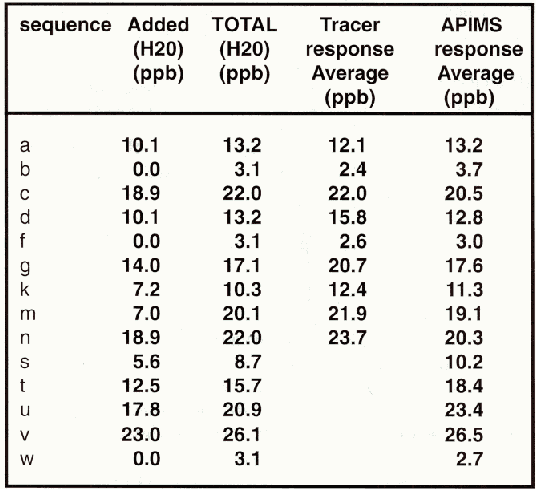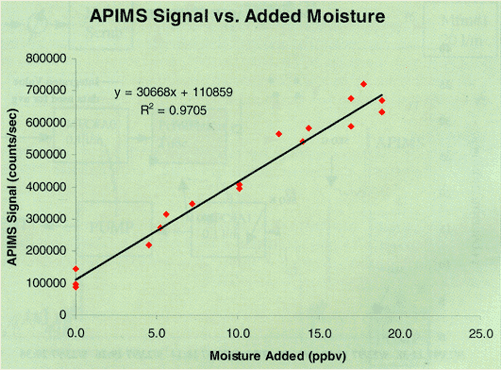
Test conducted by Professor Alan Bandy, Drexel University and Armando Velasquez, MEECO, Inc.
Absolute methods of analysis such as gravimetric, volumetric and coulometric offer superior accuracy and precision than methods based on calibration.1 Recent advances in coulometric hygrometry allow accurate moisture measurements in gases to sub parts-per-billion (ppb) levels. The following report compares the performance of such a hygrometer, the MEECO Tracer, with an atmospheric pressure ionization mass spectrometer (APIMS). Recognized in the semiconductor industry as a high-performance laboratory instrument, the APIMS is often used as a benchmark in evaluating equipment. In this comparison, traceable moisture challenges in the range from 5 to 25 ppb were created. The resulting data showed that the Tracer tracked the APIMS exceptionally well.
1. Hulanicki, A. “Absolute Methods in Analytical Chemistry,” Pure and Applied Chemistry, 67(11), pp. 1905-1911.
This experiment tested the response of the MEECO, Inc. Tracer moisture analyzer over the concentration range 5 to 25 parts per billion by volume (ppbv).
To do this we constructed the manifold system shown in Figure 1. The manifold was constructed from 0.25-inch o.d. ultra smooth, stainless-steel tubing and VCR fittings manufactured by CAJON® Co. Liquid nitrogen boil-off having a moisture level of about 20 ppbv was used as a source of dry nitrogen. The nitrogen was further dried to approximately 3.1 ppbv using an Aeronex GateKeeper Model 500K scrubber.
The flow rates f1 to f8 indicated in Figure 1 were measured with either mass flow controllers or mass flow meters calibrated with a Model DC-2M flow calibrator manufactured by BIOS International Corp. (traceable to NIST). The moisture level was monitored with a Model ATTO SPEC I Extrel atmospheric pressure ionization mass spectrometer (APIMS) using a corona discharge ionization source. Two water permeation tubes were purchased from VICI Metronics Inc. The masses of these tubes were monitored as a function of time with a Model AP290D OHAUS Inc. electronic balance having an accuracy of ± 1 0-5 grams. The permeation tubes were maintained at 41.0ºC and had permeation rates of 271.6 nL/min and 299.2 nL/min respectively.
NOTE: The manifold was checked for leaks by pressurizing it with He to 60 psi through a 2OmL/min mass flow meter. The maximum leak rate was ±0.03 mL/min. The manifold was dried by purging it with dry N2 for 2 days. A flow rate of about 13 L/min was maintained in the manifold during the runs. The manifold pressure was maintained at about 30 psi and the manifold temperature was maintained at 150ºC.
The amount of H20 vapor added to the manifold was controlled by regulating the fraction of the H20 emitted by the permeation tube introduced into the manifold. This fraction was adjusted by regulating f3.
The MEECO Tracer response to water was investigated over the range 5 to 25 ppbv. The time series used in this analysis are shown in Figure 2 and 3. The regions used to obtain the averaged data used in the analysis are shown as segments in these figures. The data, averaged over each segment, is shown in Table 1.
A plot of the APIMS response in counts per second (cts) as a function of added moisture in parts per billion by volume (ppbv) is shown in Figure 4. Visually the plot was linear which was confirmed by regression methods. Using linear regression we found the slope and standard error of the slope were 3.07 x 104 cts/ppbv and 1300 cts/ppbv.respectively. The intercept, and standard deviation of the intercept were 1.11 x 105 and 1.6 x 104 Cts. The correlation coefficient (R2) was 0.97.
Using the APIMS sensitivity we converted the count rates, obtained when no H20 was added, to a “background” H2O level in ppbv. This background H20 vapor level in the dry N2 steam after the purifier averaged 3.1 ppbv. We used these data to develop the plot of moisture level obtained from APIMS as a function of moisture level shown in Figure 5. The ordinate of Figure 5 was obtained by dividing the APIMS count rate by the sensitivity (the slope of the curve in Figure 4). The total H20 vapor level, shown as the abscissa of Figure 4, was obtained by adding the 3.1 ppbv background H20 vapor level to that added from the permeation tube system. Data from both permeation tubes were included in this analysis.
The response of the MEECO Tracer instrument to water vapor also is shown in Figure 5. The MEECO instrument response was linear, having a slope, standard error of the slope, intercept and correlation coefficient (R2) of 1.09, 0.06, -0.2 and 0.98, respectively. The differences in slopes and intercepts of the MEECO Tracer instrument and the APIMS are insignificant at the 95% confidence level.
Overall the APIMS and MEECO instrument track each other well.
Alan R. Bandy, PhD, is a professor of atmospheric and analytical chemistry at Drexel University. He received is PhD degree in chemistry from the University of Florida in 1968. Bandy is a member of Experiment Planning Committee, NASA Aircraft Emissions Assessment Program Science Team, NSF Aerosol Characterization Experiment I Co-mission Scientist, and NASA Pacific Exploratory Mission Equatorial Science Team. He is the author of 26 publications in the last five years.
Armando Velasquez is a product development engineer and research assistant in the Research & Development Department at MEECO, Inc. He received his Master degree in Physics from Drexel University in 1991. Velasquez is a member of the International Society of Optical Engineers and the Project Management Institute.
